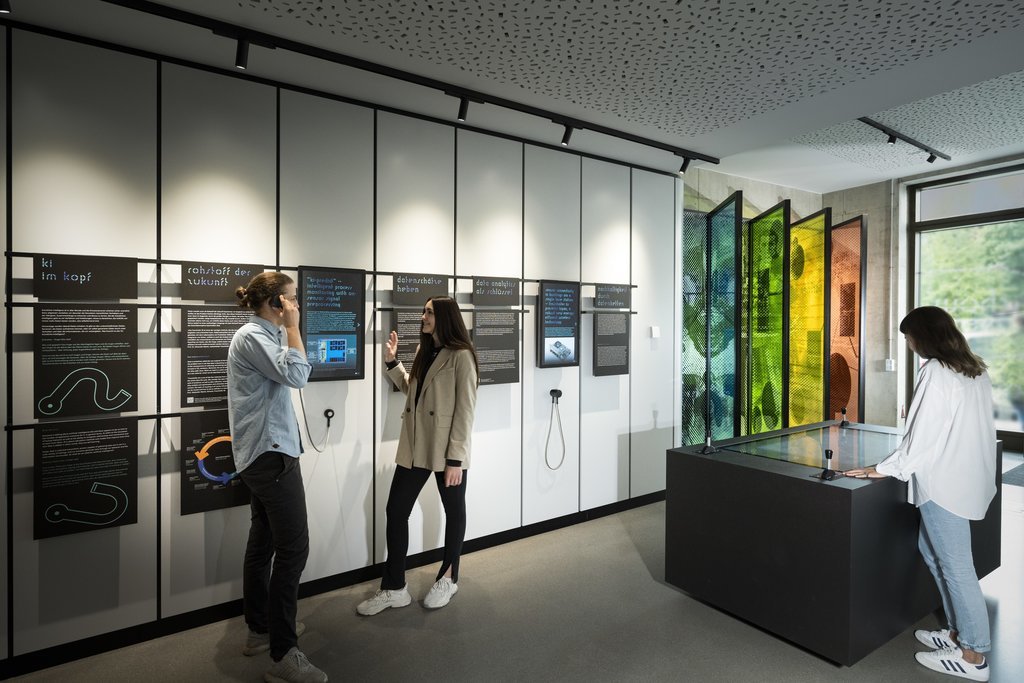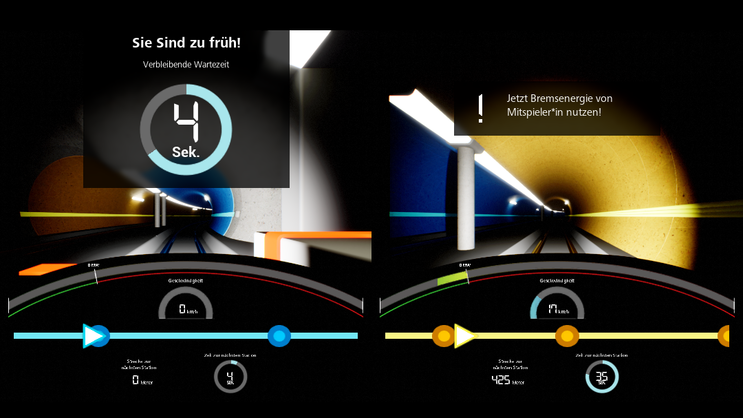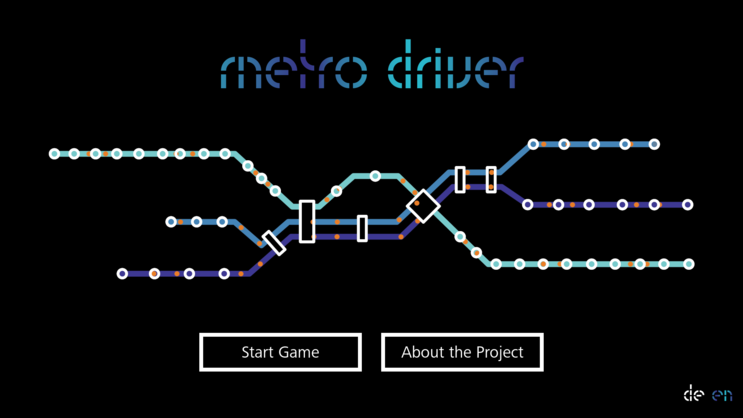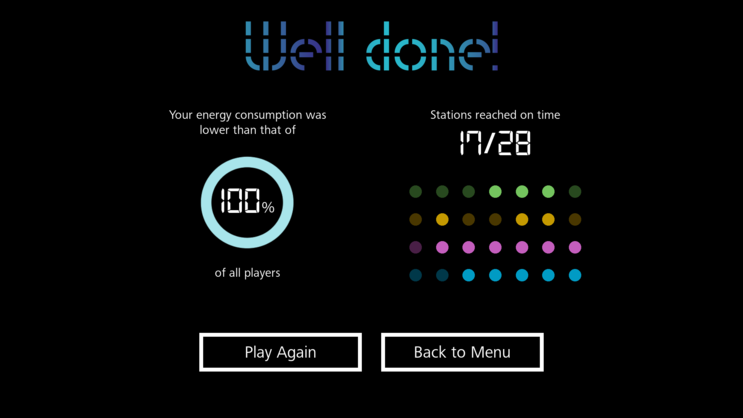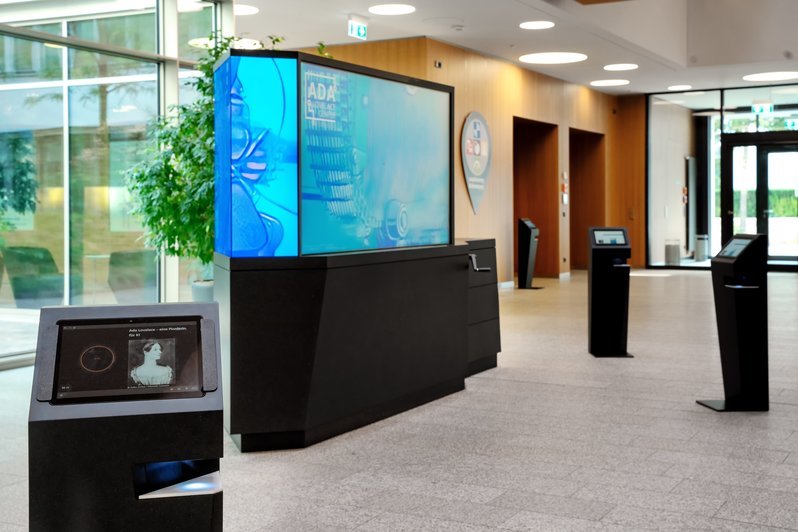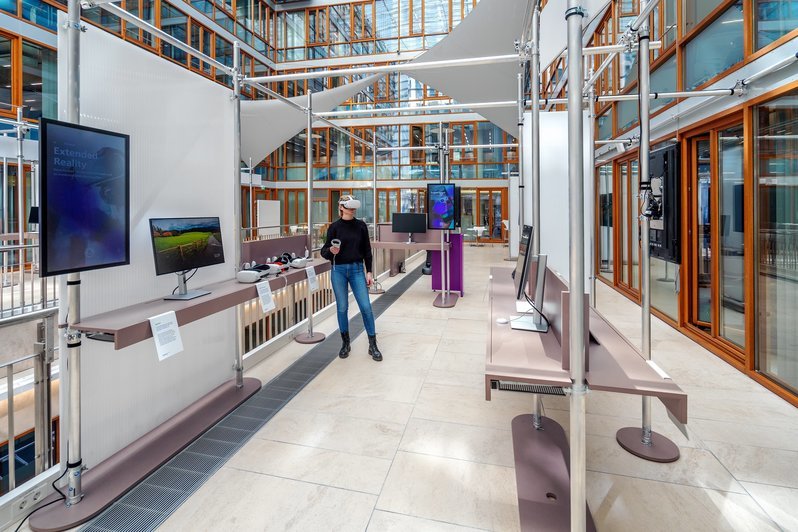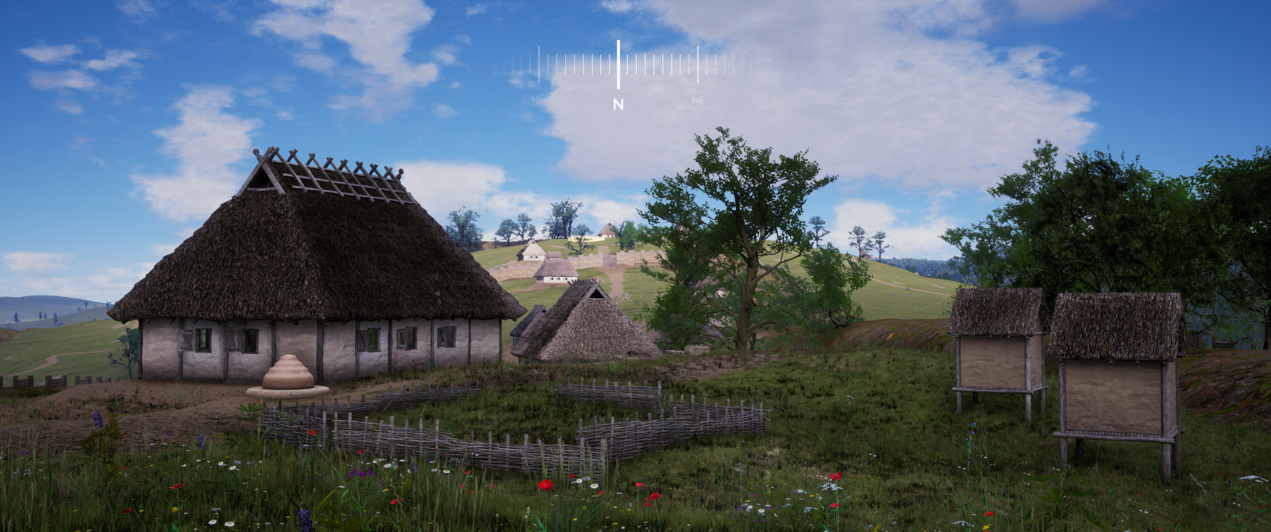For the renowned German research organization Fraunhofer Institute for Integrated Circuits IIS, we developed a showroom that makes research accessible for everyone. Right in the center of Nuremberg, a new premise invites clients, partners, potential employees and the general public to get to know the institute, its achievements and projects.
A new touchpoint
leaving the ivory tower
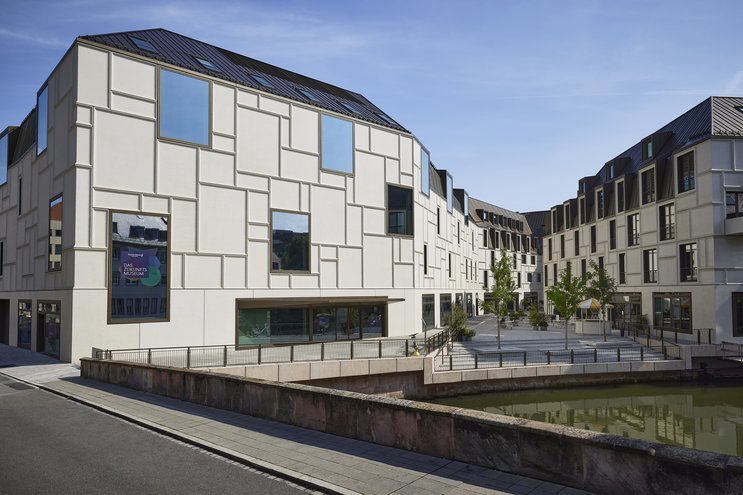
The Fraunhofer Institute for Integrated Circuits or Fraunhofer IIS in short conducts cutting-edge research in the field of microelectronics and information technology. Since the campus is located in a commercial area on the outskirts of Erlangen, the work of the 1,100 employees goes largely unnoticed by the general public. In addition, there was no representative room for meetings with customers, possible employees and partners in an urban location.
MESO was commissioned to design a representative showroom in the Augustinerhof below the Zukunftsmuseum / Deutsches Museum Nuremberg and to design and implement the exhibition with a focus on artificial intelligence and the work of the institute.
Constraints were the small space, the many target groups and the complex brand communication through the differentiation between the Fraunhofer IIS, the larger Fraunhofer Gesellschaft and the Josephs Innovation Lab (named after Joseph von Fraunhofer).
The space, which was developed in close cooperation with Just Architekten, enables a common flow of visitors, but is also divided into clear areas. The Fraunhofer IIS showroom is visually self-contained thanks to its consistent design.
Partnering up with Georg-Christoph Bertsch from B.BC and Marie Schoppmann from VERY, we developed an individual concept and appearance for the showroom that combines Fraunhofer CI guidelines with new elements and concepts. From storefronts to screen content, this unified design ties all media together and gives them a recognizable look.
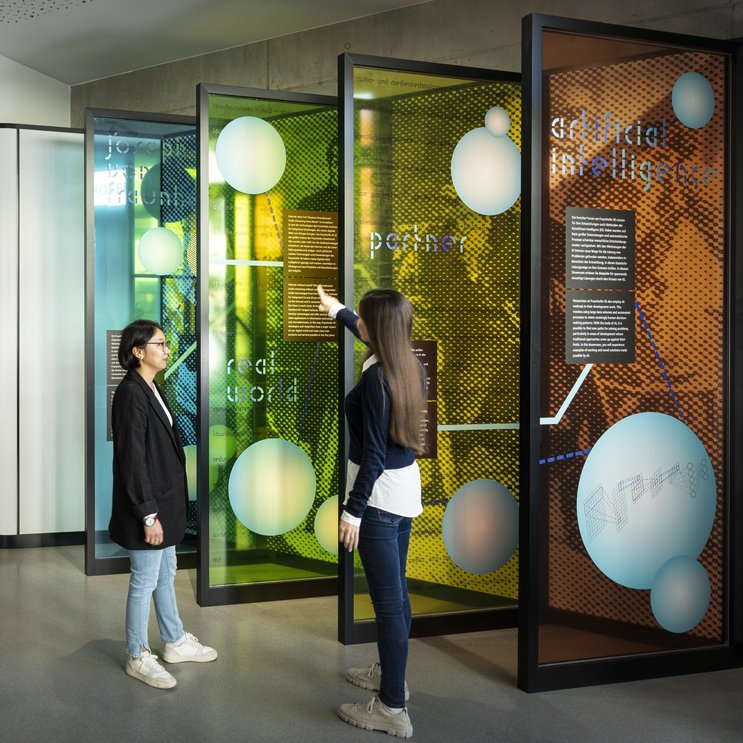
Branding
On entering the showroom, four colorful glass panels introduce the visitors to Joseph von Fraunhofer and his experiments with spectral colors. They lay the basis to explain the more colloquial Josephs startup accellerator and the larger Fraunhofer Society. The history of its founder and the society, main research projects, and the current focus on artificial intelligence are highlighted.
Exhibition
The central topic of the first exhibition in the room is AI, but an important requirement was that other topics should also be able to be depicted later, since the research of the institute are constantly evolving. We have designed a flexible exhibition system that is mounted on two wall surfaces of the exhibition space. Within a fixed grid, analog panels and touch monitors are combined to create a unique information infrastructure. Both media follow the same design principles, so that printed and digital content merge seamlessly.

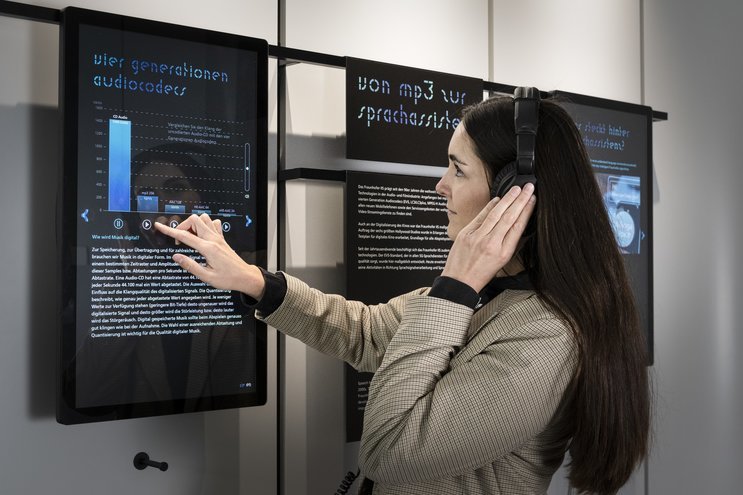
Connected to a custom CMS the articles and media displayed on the portrait-format exhibition monitors can be edited and updated by the client any time.
Heritage wall
The MP3 audio codec which completely revolutionized the way music was consumed in the early 1990s is a development by Fraunhofer IIS.
Even though research in this area of course has proceeded since then, we wanted to give this milestone a prominent place in the exhibition: The central wall – which can also be seen from the outside through the windows – is staged with an artistic light installation. The song “Tom’s Diner” by Suzanne Vega was originally used by Fraunhofer engineers to tweak the MP3 algorithm so that the tiny distortions in the delicate voice became clearly audible. A line from the famous chorus was translated into an interactive light installation.
Employees can choose between different light animations – from subtle and calm during the day to strong and energetic for evening events.
The current research of the IIS on audio codecs is shown in the adjacent part of the exhibition.
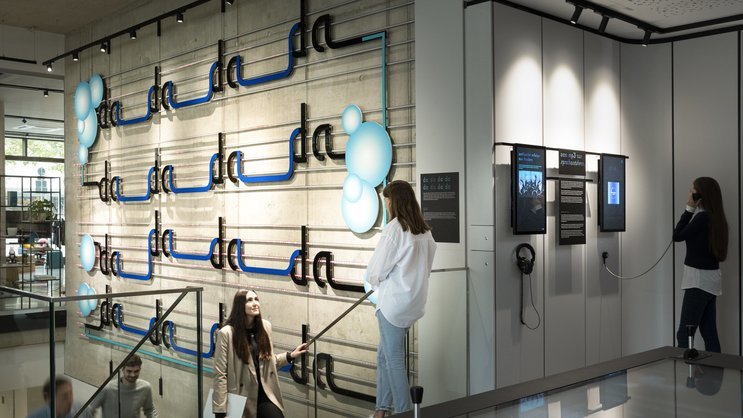
Network lounge
The rear part of the showroom is dedicated to presenting the Fraunhofer IIS as a partner and employer. A spatial element creates a private meeting area with an integrated work space. The large touch monitor can be connected to the devices of Fraunhofer employees to display presentations.
When in idlemode, a fine tuned logic of visual elements and media give an insight into the work of the institute and can be enlarged on touch to obtain more information.
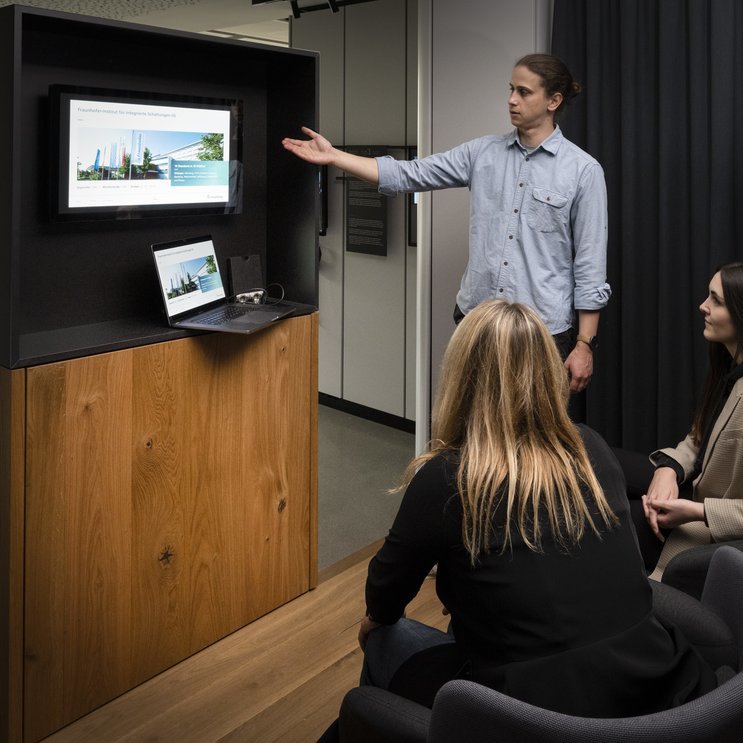
Real-world AI
Playful learning
The highlight of the showroom is the bespoke multi-player game “Metro Driver”.
In a systematic process, we analyzed dozens of use cases to find those that are suitable for a game, and that explain the benefits of artificial intelligence using a real, forward-looking and relevant example. We picked a case around railroads and public transport as the topic has many historic connections to the city of Nuremberg:
A research team from Fraunhofer IIS and the Friedrich-Alexander-Universität Erlangen-Nürnberg was able to significantly reduce energy costs by mathematically optimizing the timetables of automated subways. The key here was to balance train acceleration and train braking across the city. If the energy from a braking train can be used directly to start another train, energy loss is minimized. The train schedule to achieve this goal was calculated using artificial intelligence – and has been saving taxpayers money ever since.
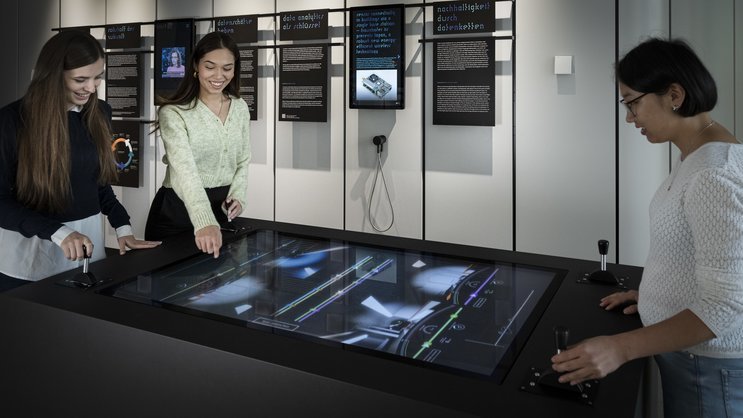
We took this tangible real project and translated it into an advanced multiplayer game: Using 3D animations and programming in Unreal Engine, we’ve created an experience that is both educational and fun.
The principle of the game sounds simple: work together as a group, communicate and find a common rhythm in order not to use up too much energy by accelerating all trains at the same time. In practice, this quickly turns out to be an exciting challenge.
The media station consists of a large touchscreen and four levers typically used in professional train simulators. Each player takes on the role of a train driver and controls one of four trains. Any empty space will automatically be occupied by an NPC (Non-Player Character).
Now all players have to operate their train carefully, keeping an eye on the timetable, their own energy consumption and that of their fellow players. In addition to helpful hints here and there, communication within the group is the key to success. Reaching as many stations as possible on time, but also reducing mutual energy consumption through coordinated acceleration, coasting and braking, leads to a final group result.
What is a fun game with four trains, is an impossible undertaking with the hundreds of trains in the Nuremberg public transport system. So thankfully we can use AI for that.
Related Projects

Curious about our approach? Feel free to get in touch!
Christian Leonhard Senior Project Manager +49 69 24 000 376 christian.leonhard@meso.design christian.leonhard@meso.design +49 69 24 000 376
MESO Digital Interiors GmbH
Gutleutstr. 96 . 60329 Frankfurt . Germany
Team
Theron Burger, Maximilian Georg, Susanne Heinlein, Sebastian Oschatz, Sebastian Quader, Marie Schoppmann, Marcus Schreiter, Timon Skerutsch, Erik Staub, Max Wolf, Christian Zollinger
